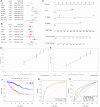Overexpression of PLCG2 and TMEM38A inhibit tumor progression in clear cell renal cell carcinoma
- PMID: 39863641
- PMCID: PMC11763014
- DOI: 10.1038/s41598-025-86644-1
Overexpression of PLCG2 and TMEM38A inhibit tumor progression in clear cell renal cell carcinoma
Abstract
Clear cell renal cell carcinoma is a prevalent urological malignancy, imposing substantial burdens on both patients and society. In our study, we used bioinformatics methods to select four putative target genes associated with EMT and prognosis and developed a nomogram model which could accurately predicting 5-year patient survival rates. We further analyzed proteome and single-cell data and selected PLCG2 and TMEM38A for the following experiments. Overexpression models of PLCG2 and TMEM38A were generated in Caki-1 and 786-O cell lines using plasmids. The in vitro experiments demonstrated that both of them exerted pro-apoptotic effects on Caki-1 and 786-O cells, inducing G2/M phase arrest, inhibiting proliferation, and suppressing EMT. In summary, we identified potential tumor suppressor factors and stratified ccRCC patients into high-risk and low-risk groups based on these factors. Furthermore, we elucidated the impact of PLCG2 and TMEM38A in Caki-1 and 786-O cell lines, offering novel avenues for therapeutic target exploration.
Keywords: PDC; PLCG2; TCGA; TMEM38A; ccRCC.
© 2025. The Author(s).
Conflict of interest statement
Declarations. Competing interests: The authors declare no competing interests.
Figures








Similar articles
-
Biological and metabolomic insights into RACGAP1-mediated growth and progression of clear cell renal cell carcinoma.Am J Physiol Cell Physiol. 2025 Jul 1;329(1):C283-C297. doi: 10.1152/ajpcell.00066.2025. Epub 2025 Jun 16. Am J Physiol Cell Physiol. 2025. PMID: 40522863
-
Effect of FLRT3 on epithelial-mesenchymal transition in clear cell renal cell carcinoma.Urologia. 2025 Aug;92(3):383-393. doi: 10.1177/03915603251319944. Epub 2025 Feb 24. Urologia. 2025. PMID: 39995192
-
The Transcription Factor CREB1 Triggers the Progression of Clear Cell Renal Cell Carcinoma by Promoting CENPE Expression.J Cell Mol Med. 2025 Aug;29(15):e70773. doi: 10.1111/jcmm.70773. J Cell Mol Med. 2025. PMID: 40794013 Free PMC article.
-
Exploring the prognostic role and expression patterns of FAM3A family genes in kidney renal clear cell carcinoma.Sci Rep. 2025 Jul 1;15(1):22397. doi: 10.1038/s41598-025-05658-x. Sci Rep. 2025. PMID: 40594565 Free PMC article.
-
Assessing the comparative effects of interventions in COPD: a tutorial on network meta-analysis for clinicians.Respir Res. 2024 Dec 21;25(1):438. doi: 10.1186/s12931-024-03056-x. Respir Res. 2024. PMID: 39709425 Free PMC article. Review.
References
-
- Sung, H. et al. Global cancer statistics 2020: GLOBOCAN estimates of incidence and mortality worldwide for 36 cancers in 185 countries. CA Cancer J. Clin.71(3), 209–249 (2021). - PubMed
-
- Bukavina, L. et al. Epidemiology of renal cell carcinoma: 2022 update. Eur Urol.82(5), 529–542 (2022). - PubMed
-
- Bahadoram, S. et al. Renal cell carcinoma: an overview of the epidemiology, diagnosis, and treatment. G. Ital. Nefrol.39(3), 1 (2022). - PubMed
-
- Znaor, A., Lortet-Tieulent, J., Laversanne, M., Jemal, A. & Bray, F. International variations and trends in renal cell carcinoma incidence and mortality. Eur. Urol.67(3), 519–530 (2015). - PubMed
Publication types
MeSH terms
Grants and funding
LinkOut - more resources
Full Text Sources
Medical

